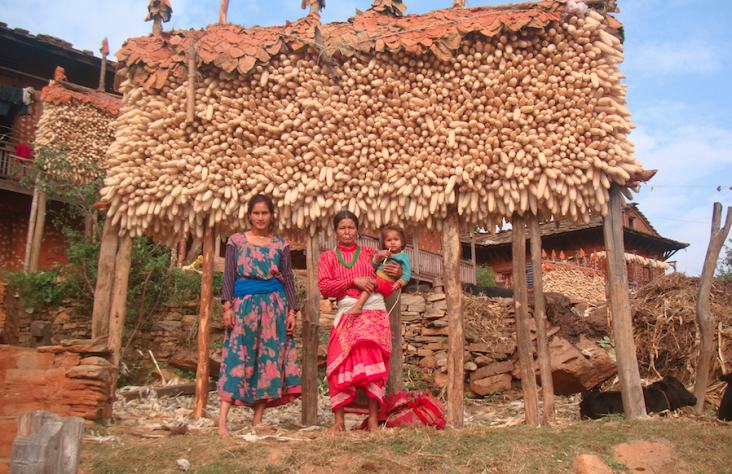
There is a common saying in Nepal, “If there is no maize, there is nothing to eat.” Yet this staple crop, which makes up about a quarter of the country’s food grain supply, is in jeopardy. Climate change and limited access to new information and technology in the hill region are key challenges. Many families are consequently trapped in a cycle of extreme poverty, chronic hunger, and undernutrition.
USAID’s Hill Maize Research Program (HMRP IV) has taken aim at the issues of food insecurity, poverty, and climate change through improved seed varieties and better crop management technologies. The program, part of the U.S. Government’s Feed the Future initiative and implemented by the International Maize and Wheat Improvement Center (CIMMYT) in partnership with government, NGO, and community stakeholders and private seed companies, is working across the middle hills of Nepal to boost maize production, empower disadvantaged populations, and strengthen communities in a sustainable way.
HMRP’s first three phases were funded by the Swiss Agency for Development and Cooperation from 1999 to 2010. In 2010, USAID stepped in to jointly fund the program’s fourth phase. In this phase, the program is increasing the food security, nutrition, and incomes of more than 56,000 farm families in 20 hill districts by developing improved maize varieties and introducing conservation agriculture techniques that improve agricultural water management and nutrition.
Local Farmers Decide the Best Fit
First, the program’s researchers worked to develop a maize variety that could tolerate drought and, in some areas, water logging – critical issues in Nepal’s hill region. “With climate change and variability, maize farmers in the hills of Nepal were facing serious crop losses every year and the entire maize value chain was at risk,” said Nirmal Gadal, former HMRP team leader for CIMMYT.
HMRP extension and research partners joined forces with men and women farmers from disadvantaged communities throughout the country to learn which maize varieties would be most effective in their local contexts. Participating farmers worked with scientists to compare five or six new maize varieties with their own local varieties and shared the results, yielding new types of seeds that HMRP proposed for wider adoption in the region. “This community-based seed production program was a key approach,” said Dilli KC, Seed Value Chain and Marketing Expert, HMRP CIMMYT-Nepal.
Yields increased by up to 75 percent with the new maize varieties, which are not only higher yielding, but also more climate and disease-resistant. HMRP then worked to institutionalize participatory variety selection in the national research and extension systems. In 2013, the Government of Nepal approved the nation’s first seed policy document, “National Seed Vision: 2013-2025,” which HMRP helped to develop. HMRP also collaborated with the Ministry of Agriculture Development to draft a national seed policy that enables new climate-resistant seeds to be distributed across the country. “The slow nature of bureaucracy made the process challenging, but the program worked side-by-side with the Government of Nepal to start to address the needed updates to seed regulations and policies,” said Mr. Gadal.
The project also helped farmers form seed producers’ groups. Members benefit from increased income, and their peers benefit from a reliable means of accessing the improved seeds. Nanu Maya Ghatani, chairperson of a women’s seed cooperative, said that her income has doubled due to the program.
More Than Seeds – Sustainability
HMRP is not just about working with seeds. It is also working with farmers to combat climate change in 10 hill locations through conservation agriculture trials. “We need to be more productive with the water we have,” said Beverly McIntyre, USAID Water Resources Advisor. “Successful agricultural water management is holistic in its approach.” And HMRP is doing just that.
The program encourages farmers to keep about 30 percent of their crop residue on the soil surface to improve water moisture and better meet the biological and chemical needs of the soil and promotes minimal crop tillage to retain water and nutrients in the soil. It also encourages crop rotation and intercropping of maize and vegetables (high value crops such as tomatoes, cabbage, and ginger) and maize and legumes, which result in better soil quality and nutrition for families.
These new techniques have been particularly life changing for Nepal’s most vulnerable farmers, including women, Dalits (socially and economically disadvantaged populations), and Janajatis (indigenous nationalities). New technologies have taken tedious activities traditionally assigned to women and mechanized them, making time for more productive work. “Women farmers are not only able to send their children to school, but also feel more safe and sound in their family and society,” said Ms. Ghatani, the women’s cooperative chairperson. Sixty-three percent of the farmers in the program are women and 71 percent are disadvantaged.
Now the project’s public-private partnerships will continue to ensure quality maize production while strengthening communities for the long term. “The program’s holistic approach addresses both the natural resources and the people who depend on them, through gender and social inclusion and community governance,” said Dr. KC. Without including all of these, there is truly nothing to eat.
A. Gambrill







Comment
Make a general inquiry or suggest an improvement.